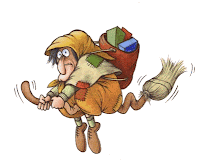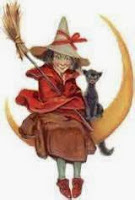The shopping season is upon us. I don't know about you,
but I'm swamped.
Ann to the rescue.
I've got a way for you to put off the shopping ordeal
until after Christmas...as long as
you get it done before January 5.
SANTA
CLAUS IS COMING
When I lived in Rome in the 1960s, Santa Claus was almost
non-existent. Oh, Babbo Natale
(Father Christmas) had been visiting Italy since WWII—he wasn’t completely
unknown—but Italian children didn’t leap out of bed at the crack of dawn
Christmas day and run to see what Santa had brought them. Instead, in Italy, the
day children received gifts was January 6, La
Befana (The Epiphany).
The Befana is a big part of the Italian Christmas tradition—I don't know if Italian-Americans celebrate it; we never did—and, like many
holidays, mixes legend, tradition and a little religion.
IT'S
A BIRD, IT'S A PLANE, IT'S...LA BEFANA?
[I'm dating myself; but if you're old enough, you know
how the phrase really ends.]
The Befana is a good witch [a nice but ugly old woman
with a long, hooked nose] who, on the night between January 5th and
6th (which is the eve of the Feast of the Epiphany) flies on a
broomstick to visit all the children of Italy.
She enters the houses through
the chimneys and, from the sack she carries, she fills the children's stockings
with sweets and small presents if they have been good or a lump of coal or dark
candy if they have been bad. Sounds a tad familiar, right?
Although she wears an old, long skirt filled with colorful
patches and a black shawl, she is a good housekeeper and will sweep the floor
before she leaves. The child's family typically leaves a small glass of wine
and a plate with a few morsels of food, often regional or local, for the good witch.
In most regions of Italy, even adults give little
presents to each other, and so do lovers, along with stockings full of
chocolates.
THE
EPIPHANY
According to Wikipedia, Epiphany "is a Christian
feast day that celebrates the revelation of God the Son as a human being in
Jesus Christ." Martha Bakerjian, on Goitaly.about.com describes the
Epiphany as the 12th day of Christmas when the three Wise Men
arrived at the manger bearing gifts for the Baby Jesus. Without going into the
details, the celebration has been around since at least 380 AD.
It is celebrated by most on January 6 and officially ends
the Christmas holiday. In Italy, everyone takes down the decorations on that
day. There is an Italian saying that "The Epiphany takes away all
festivity."
THE
LEGEND OF THE BEFANA
Like everything else, there are a number of theories
about origins of the "good witch" including the celebration of the
Epiphany and the idea that she's an heir descendent of the Sabine/Roman goddess
named Strina, who presided over the new-year's gifts of figs, dates, and honey.
It's also suggested she's the Christian substitute for the old crone who read the augers at the pagan festival of Saturnalia.
It's also suggested she's the Christian substitute for the old crone who read the augers at the pagan festival of Saturnalia.
"According to the
legend, the night before the Wise Men arrived at the manger, they stopped as
the shack of an old woman to ask directions. They invited her to come along,
but she replied that she was too busy. Then a shepherd asked her to join him,
but again she refused. Later that night, she saw a great light in the sky and
decided to join the Wise Men and the shepherd bearing gifts that had belonged
to her child who had died. She got lost and never found the manger.
Now, La Befana flies around on her broomstick each year on the 11th night of Christmas in hopes that she might find the Baby Jesus.
Now, La Befana flies around on her broomstick each year on the 11th night of Christmas in hopes that she might find the Baby Jesus.
Although she has been
unsuccessful in her search, she still leaves gifts for good young children
because the Christ Child can be found in all children." http://www.goitaly.about.com
Another variation of the Three Wise Men legend is the
same up to the point where the old woman has regrets about not going with the
Wise Men.
"So she made lots of
cakes and walked around outside her home, offering cakes to all the children
she met on her way, hoping one of them were Jesus. Since then, Befana brings
gifts to all the children." http://www.mybefana.it/
In still another version, found on Wikipedia, La Befana was an ordinary woman with a
child she greatly loved.
"However, her child
died, and her resulting grief maddened her. Upon hearing the news of Jesus
being born, she set out to see him, delusional that he was her son. She eventually
met Jesus and presented him with gifts to make him happy.
The infant Jesus was delighted, and he gave La Befana a gift in return; she would be the mother of every child in Italy."
The infant Jesus was delighted, and he gave La Befana a gift in return; she would be the mother of every child in Italy."
BITE
THE BULLET
Now, go tell your children and/or grandchildren they have to wait until January 6th to open their presents. Oh, yeah. That's going to go well.
Now, go tell your children and/or grandchildren they have to wait until January 6th to open their presents. Oh, yeah. That's going to go well.
ANOTHER
WAY TO CELEBRATE THE EPIPHANY
And by the way, if you're running out of ideas for an
Epiphany celebration, remember last February's blog about the Russian Orthodox version.
In Russia, thousands plunge themselves into icy rivers and lakes to cleanse
themselves of sins with water deemed holy. The overnight temperature there at
this time of year often drops to about 14° F.
This makes waiting until January 6 for presents look not
so bad after all.
HOWEVER
YOU CELEBRATE THE SEASON, MAY IT BE WONDERFUL FOR YOU AND YOUR FAMILY.
□
□
Blog
Resources
http://en.wikipedia.org/wiki/Epiphany_%28holiday%29
http://goitaly.about.com/od/festivalsandevents/a/epiphany.htm
https://seethesea.wikispaces.com/La+Befana%2C+an+Italian+tradition
http://www.historyandwomen.com/2009/12/legend-of-la-befana.html
http://goitaly.about.com/od/festivalsandevents/a/epiphany.htm
https://seethesea.wikispaces.com/La+Befana%2C+an+Italian+tradition
http://www.historyandwomen.com/2009/12/legend-of-la-befana.html




Very interesting, Ann. Thanks. My grandparents came from Italy and we grew up with Italian traditions but I've never heard of La Befana. I do know that different cultures celebrate Christmas on Jan. 6, the Feast of the Epiphany.
ReplyDeleteGreat post, Ann! Fun and informative.
ReplyDeleteI love learning about new holidays! Thanks for sharing. There's a fun book...Throw Your Tooth on the Roof which tells of tooth fairy traditions around the world. I'd love to see a Christmas book too!
ReplyDeleteLOL I enjoyed the Italian traditions, and learning about LA BEFANA.
ReplyDeleteWe never took our Christmas decorations down until after 6 Jan. - had to wait! But we did our gifts on Christmas. Also, kept baby Jesus covered under a tissue/cloth in the nativity scene until Christmas Day. Not sure if it's an Italian "thing", but all my family did it.
ReplyDelete